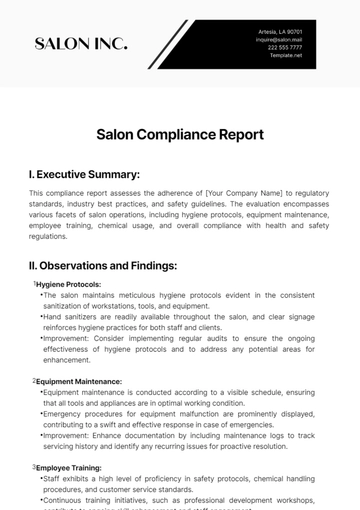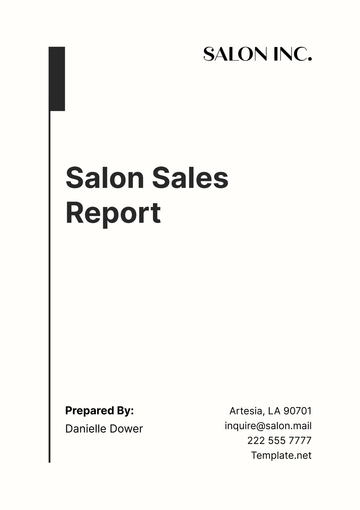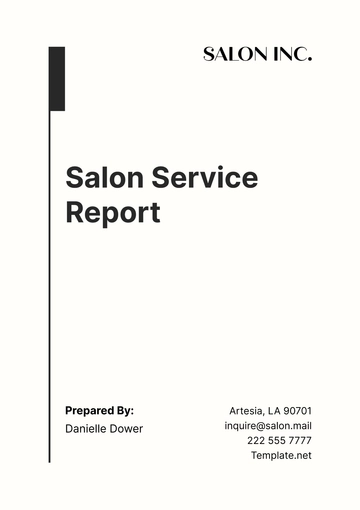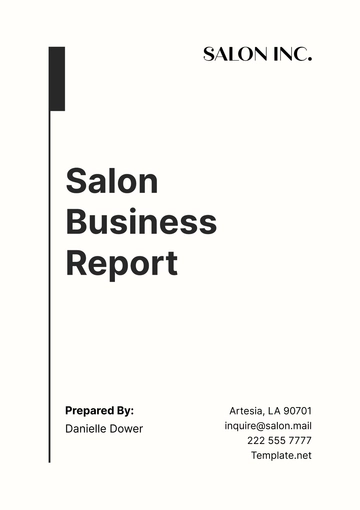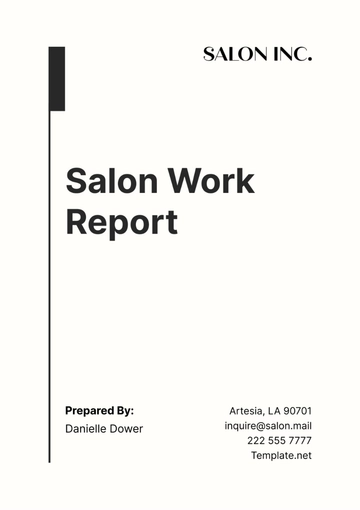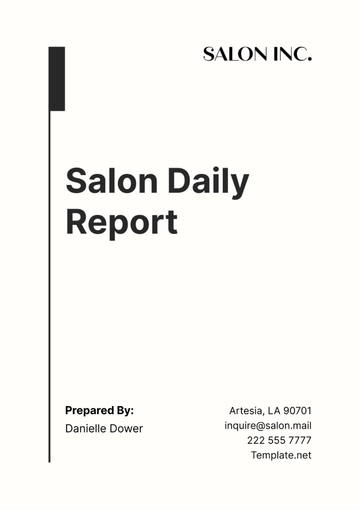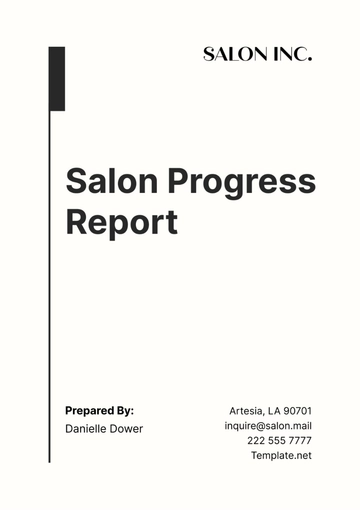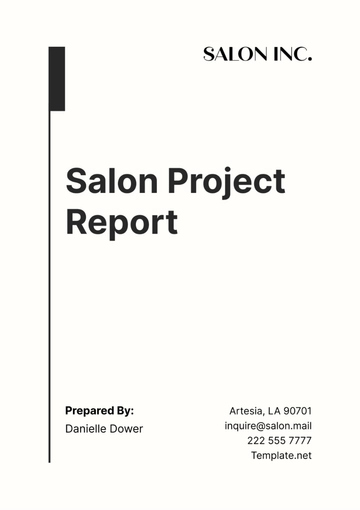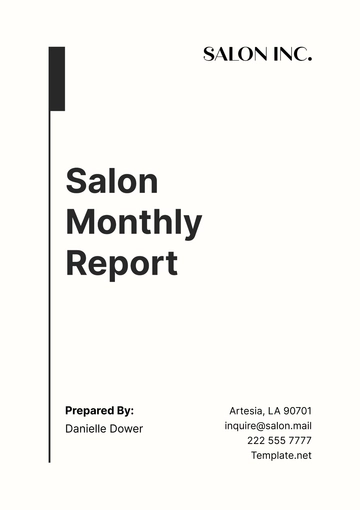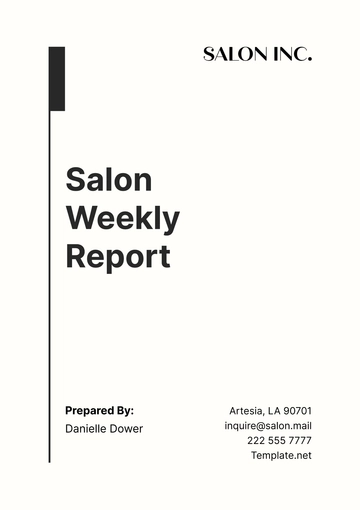Free Salon Business Report
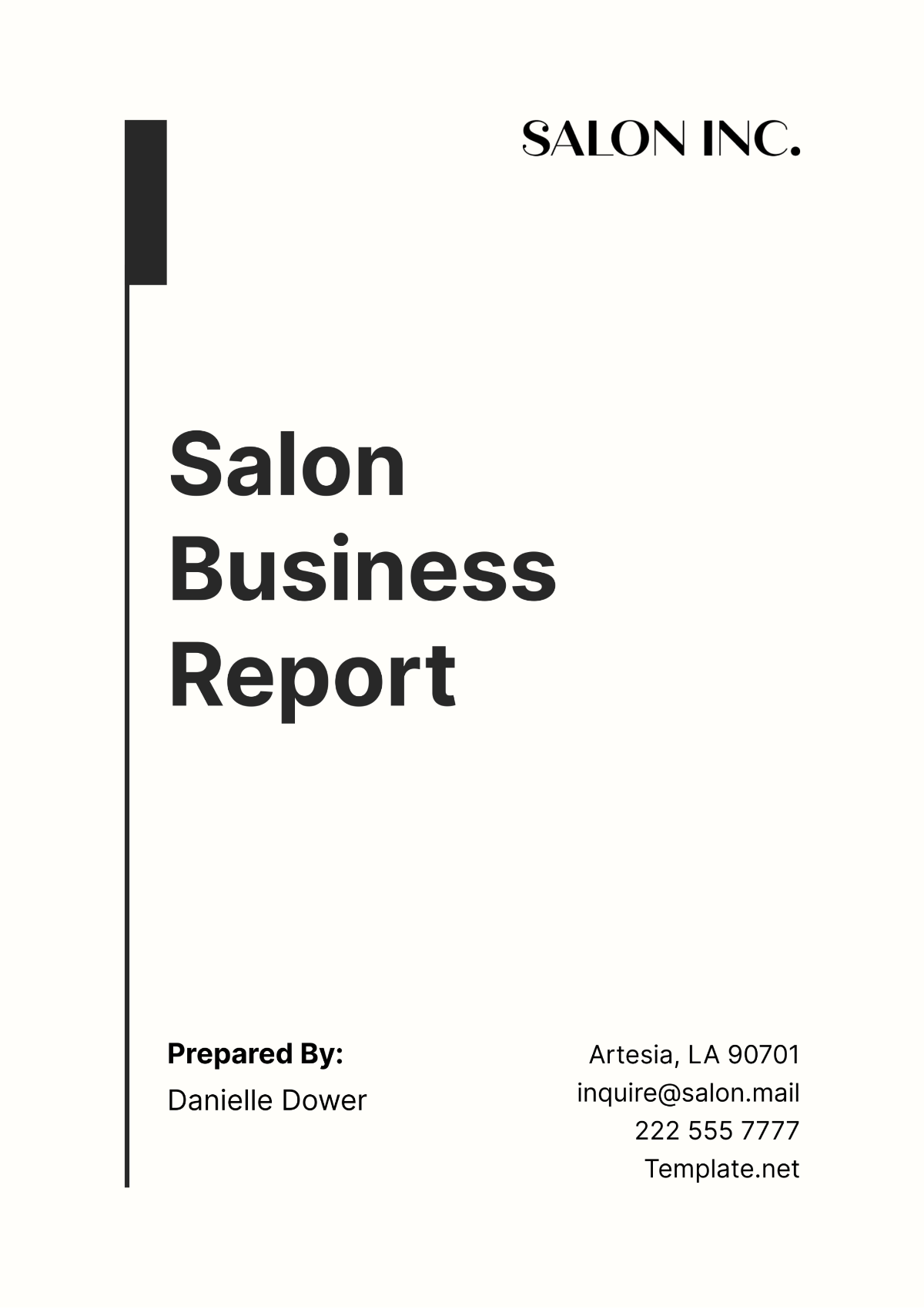
1. Executive Summary
Objective of the Report
The primary objective of this report is to provide a detailed analysis of [Your Company Name]'s operations, market position, and financial health within the hair and beauty salon industry. This report aims to identify strategic opportunities and actionable insights to enhance business performance and competitiveness.
Key Findings
[Your Company Name] has steadily increased its customer base by 20% year-over-year due to strategic marketing and high client satisfaction rates.
The financial analysis reveals a profit margin increase of 5% from the previous year, driven by higher-margin services and effective cost management.
Competitive analysis shows that [Your Company Name] holds a 15% market share in the local area, ranking third among competitors.
Recommendations
Expand the range of high-margin services offered, focusing on emerging beauty trends.
Increase investment in digital marketing to enhance online presence and attract a younger demographic.
Implement a customer loyalty program to boost repeat business and customer retention.
2. Introduction
Background
[Your Company Name] operates within the dynamic and competitive hair and beauty salon industry. Founded in [Year], the salon has established itself as a reputable provider of high-quality hair styling, coloring, and beauty services in [Your Company Address]. The salon industry is influenced by consumer trends, economic conditions, and technological advancements.
Scope of the Report
This report covers a comprehensive analysis of [Your Company Name]'s business operations, market environment, marketing strategies, and financial performance. It examines internal and external factors affecting the business and provides strategic recommendations for growth and improvement.
Methodology
The information in this report was collected through a combination of methods:
Customer surveys and feedback forms to assess satisfaction and service quality.
Financial data analysis from the past three years.
Market research reports and industry publications to understand market trends and competitive dynamics.
3. Industry Analysis
Market Overview
The hair and beauty salon industry is valued at approximately $50 billion in the United States, with an annual growth rate of 2.5% over the last five years. Salons offering specialized services such as organic treatments and premium beauty products are seeing faster growth, reflecting changing consumer preferences toward luxury and wellness.
Table 1: Industry Growth Trends
Year | Industry Value ($ billion) | Growth Rate (%) |
|---|---|---|
Year 1 | 45.5 | 1.8 |
Year 2 | 46.7 | 2.6 |
Year 3 | 47.2 | 1.1 |
Year 4 | 48.5 | 2.8 |
Year 5 | 50.0 | 3.1 |
Competitive Landscape
The local competitive landscape includes a mix of independent salons and franchise chains. [Your Company Name] competes primarily with two major players: [Competitor 1] and [Competitor 2], both of which hold larger market shares of 20% and 25%, respectively. These competitors offer similar services but at a lower price point, leveraging economies of scale.
Customer Demographics
[Your Company Name]'s primary customer base consists of females aged 25 to 45 who prefer premium services. Approximately 70% of clients are repeat customers, indicating strong loyalty and satisfaction. The demographic profile shows a preference for eco-friendly and organic products.
4. Business Operations
Business Model
[Your Company Name] operates a full-service salon offering hair cutting, coloring, styling, and various beauty treatments. The business model emphasizes quality and customer experience, with a premium pricing strategy that reflects the high standard of services and products used.
Facilities and Locations
The salon is located in a high-traffic urban area conducive to walk-ins and regular appointments. The facility spans 2,500 square feet, featuring a modern design with private sections for different services to ensure customer comfort and privacy.
Technology Use
The salon utilizes an advanced booking system that allows customers to book appointments online through a user-friendly interface. The CRM system helps manage customer relationships by tracking service history, preferences, and feedback, which is used to tailor marketing efforts and improve service delivery.
5. Marketing Strategy
Marketing Mix
Product: High-quality hair and beauty services, including exclusive treatments such as organic hair masks and aromatherapy facials.
Price: Pricing is set 10-15% higher than the local average, justified by superior service quality and exclusive product offerings.
Place: Centrally located in an upscale neighborhood, the salon is easily accessible to the target demographic.
Promotion: Marketing efforts include online advertising, social media engagement, and local community events.
Customer Engagement
Strategies to enhance customer engagement include monthly newsletters, birthday discounts, and regular updates on new services and products via social media. The salon hosts bi-annual customer appreciation events to foster community and loyalty.
Social Media and Online Presence
[Your Company Name] maintains an active presence on platforms such as Instagram, Facebook, and Pinterest, showcasing before-and-after photos, beauty tips, and customer testimonials. The salon's website is optimized for SEO, resulting in a 30% increase in online bookings over the past year.
6. Financial Analysis
Revenue Streams
[Your Company Name]'s financial performance is primarily driven by three key revenue streams:
Hair Services (60% of total revenue): Includes cuts, coloring, treatments, and styling.
Beauty Services (30% of total revenue): Encompasses facials, manicures, pedicures, and other aesthetic treatments.
Product Sales (10% of total revenue): Retails high-quality hair and skin care products.
Table 2: Revenue Breakdown for the Last Three Fiscal Years
Year | Hair Services Revenue ($) | Beauty Services Revenue ($) | Product Sales Revenue ($) | Total Revenue ($) |
|---|---|---|---|---|
Year 1 | 300,000 | 150,000 | 50,000 | 500,000 |
Year 2 | 330,000 | 165,000 | 55,000 | 550,000 |
Year 3 | 360,000 | 180,000 | 60,000 | 600,000 |
Cost Analysis
The major costs involve staff salaries, rent, utility bills, and the cost of consumables. The strategic decision to use premium products slightly increases the cost of consumables but enhances customer satisfaction and allows for premium pricing.
Table 3: Cost Breakdown for [Year]
Expense Category | Cost ($) | Percentage of Total Expenses |
|---|---|---|
Staff Salaries | 240,000 | 48% |
Rent | 72,000 | 14.4% |
Utilities | 18,000 | 3.6% |
Consumables | 90,000 | 18% |
Marketing | 30,000 | 6% |
Miscellaneous Expenses | 50,000 | 10% |
Total Expenses | 500,000 | 100% |
Profitability Analysis
Over the past three years, the profit margins at the salon have seen an improvement as a result of the salon’s optimization of its range of services and the enhancement of the sale of products that yield a higher profit margin.
Table 4: Profitability Analysis
Year | Total Revenue ($) | Total Expenses ($) | Profit ($) | Profit Margin (%) |
|---|---|---|---|---|
Year 1 | 500,000 | 450,000 | 50,000 | 10% |
Year 2 | 550,000 | 485,000 | 65,000 | 11.8% |
Year 3 | 600,000 | 500,000 | 100,000 | 16.7% |
7. Challenges and Opportunities
SWOT Analysis
Strengths | Weaknesses | Opportunities | Threats |
|---|---|---|---|
High-quality service offering | Higher price point | Expanding market for luxury services | Intense competition |
Loyal customer base | Limited marketing resources | Introduction of new beauty technologies | Economic downturns |
Strong brand reputation | Space constraints | Partnership opportunities with product brands | Changes in consumer behavior |
Current Challenges:
Price Sensitivity: Despite the high-end service quality, some segments of the market are price-sensitive, particularly during economic downturns.
Staff Retention: Retaining top talent can be challenging given the competitive nature of the industry and the demand for experienced professionals.
Growth Opportunities:
Service Expansion: Introducing new services such as microblading and laser treatments can cater to a broader client base.
Geographic Expansion: Opening new locations in neighboring cities could tap into new markets and increase brand presence.
8. Strategic Recommendations
Short-term Strategies
Enhance Online Marketing:
To capture the attention of a broader audience, [Your Company Name] should enhance its online marketing efforts. This can be achieved by investing in targeted ads on platforms frequented by our demographic, such as Instagram and Pinterest, which are visual platforms ideal for showcasing the aesthetic appeal of salon services. Furthermore, implementing SEO strategies will improve visibility in search engine results, attracting more website traffic.
Introduction of Membership Plans:
Developing a membership program can create a steady stream of revenue and enhance customer loyalty. Members could enjoy benefits like special pricing on services, priority booking, and exclusive access to new products or services. This strategy not only encourages repeat business but also fosters a sense of belonging and exclusivity among clients.
Optimizing Appointment Scheduling:
Streamlining the appointment booking process through an enhanced online system can significantly improve customer satisfaction. By allowing clients to view, book, and reschedule their appointments easily online, the salon can reduce no-shows and cancellations, optimize staff schedules, and improve operational efficiency.
Staff Training and Development:
Investing in regular training programs for staff can improve service quality and increase job satisfaction, which is critical for retaining top talent. Training could focus on new beauty techniques, customer service skills, and health and safety protocols, ensuring that the team remains at the forefront of industry standards.
Long-term Strategies
Expand Service Offerings:
To keep pace with industry trends and client demands, [Your Company Name] should consider introducing cutting-edge services such as eco-friendly treatments and advanced cosmetic procedures like microdermabrasion or non-invasive body contouring. This diversification can attract a new client base and give an edge over competitors.
Franchise Development:
To expand geographic reach without the substantial capital expenditure of opening new locations, franchising offers a viable growth strategy. By franchising, [Your Company Name] can leverage its established brand and business model, helping entrepreneurs set up their salons under the company's banner. This strategy can accelerate growth and brand presence across new markets.
Developing a Private Label Product Line:
Creating a line of branded products, such as shampoos, conditioners, and styling products, can provide a significant revenue boost. These products not only enhance the customer's post-service experience but also serve as a constant reminder of the salon's high-quality offerings. Selling these products in-store and online can increase profitability and brand recognition.
Sustainability Initiatives:
Adopting and promoting sustainable business practices can differentiate [Your Company Name] in a crowded market. Initiatives could include using environmentally friendly products, reducing waste, and implementing energy-efficient practices. These efforts resonate well with a growing segment of environmentally conscious consumers and can enhance the brand's public image.
Strategic Partnerships:
Forming partnerships with other businesses such as bridal shops, photography studios, and event planners can open new channels for client referrals. These partnerships can be mutually beneficial, increasing the client base and market reach for all involved parties.
Community Engagement:
Increasing involvement in local community events, charity drives, and sponsorships can enhance [Your Company Name]'s local presence and customer loyalty. Community engagement is a powerful tool for building brand awareness and demonstrating the company's commitment to the local community.
These strategic recommendations aim to ensure both the short-term resilience and long-term prosperity of [Your Company Name]. By focusing on these areas, the salon can strengthen its market position, enhance customer engagement, and secure a sustainable growth trajectory.
9. Conclusion
Summary of Key Points:
[Your Company Name] has demonstrated a solid financial performance with growing profitability driven by strategic service offerings and efficient cost management.
The market position is strong but faces challenges from economic sensitivity and competitive pressures.
Opportunities for expansion and diversification are significant and should be pursued to ensure long-term sustainability.
Final Thoughts:
With the salon industry evolving rapidly, particularly towards personalized and luxury services, [Your Company Name] is well-positioned to capitalize on these trends. Implementing the recommended strategies will be crucial in maintaining and strengthening the salon's market position in the coming years.
- 100% Customizable, free editor
- Access 1 Million+ Templates, photo’s & graphics
- Download or share as a template
- Click and replace photos, graphics, text, backgrounds
- Resize, crop, AI write & more
- Access advanced editor
Gain detailed insights with Template.net's Salon Business Report Template. Fully customizable and editable via our AI Editor Tool, this template compiles comprehensive data on your salon's overall performance, highlighting financial health, operational efficiency, and growth opportunities. Indispensable for strategic planning and decision-making, it supports sustained business success.
You may also like
- Sales Report
- Daily Report
- Project Report
- Business Report
- Weekly Report
- Incident Report
- Annual Report
- Report Layout
- Report Design
- Progress Report
- Marketing Report
- Company Report
- Monthly Report
- Audit Report
- Status Report
- School Report
- Reports Hr
- Management Report
- Project Status Report
- Handover Report
- Health And Safety Report
- Restaurant Report
- Construction Report
- Research Report
- Evaluation Report
- Investigation Report
- Employee Report
- Advertising Report
- Weekly Status Report
- Project Management Report
- Finance Report
- Service Report
- Technical Report
- Meeting Report
- Quarterly Report
- Inspection Report
- Medical Report
- Test Report
- Summary Report
- Inventory Report
- Valuation Report
- Operations Report
- Payroll Report
- Training Report
- Job Report
- Case Report
- Performance Report
- Board Report
- Internal Audit Report
- Student Report
- Monthly Management Report
- Small Business Report
- Accident Report
- Call Center Report
- Activity Report
- IT and Software Report
- Internship Report
- Visit Report
- Product Report
- Book Report
- Property Report
- Recruitment Report
- University Report
- Event Report
- SEO Report
- Conference Report
- Narrative Report
- Nursing Home Report
- Preschool Report
- Call Report
- Customer Report
- Employee Incident Report
- Accomplishment Report
- Social Media Report
- Work From Home Report
- Security Report
- Damage Report
- Quality Report
- Internal Report
- Nurse Report
- Real Estate Report
- Hotel Report
- Equipment Report
- Credit Report
- Field Report
- Non Profit Report
- Maintenance Report
- News Report
- Survey Report
- Executive Report
- Law Firm Report
- Advertising Agency Report
- Interior Design Report
- Travel Agency Report
- Stock Report
- Salon Report
- Bug Report
- Workplace Report
- Action Report
- Investor Report
- Cleaning Services Report
- Consulting Report
- Freelancer Report
- Site Visit Report
- Trip Report
- Classroom Observation Report
- Vehicle Report
- Final Report
- Software Report

